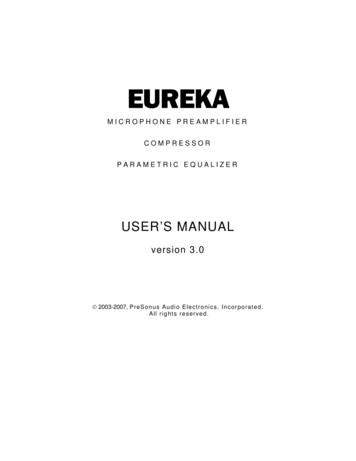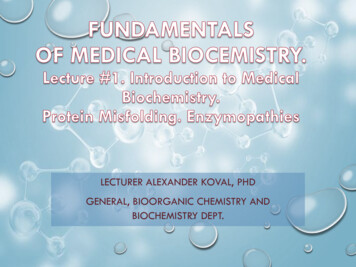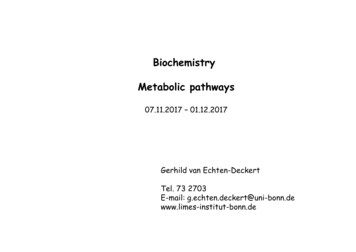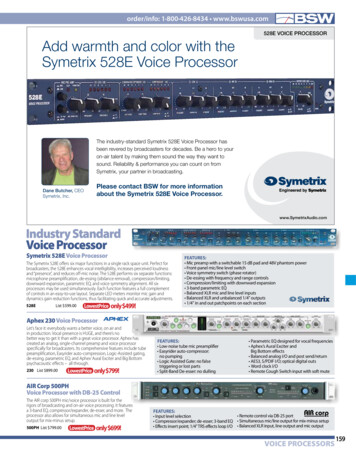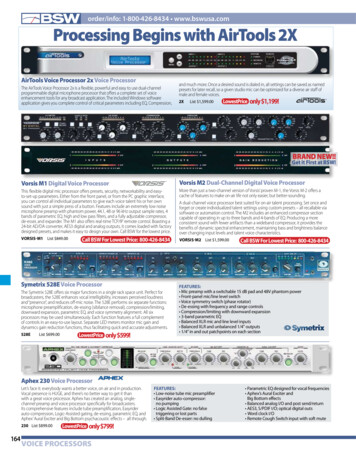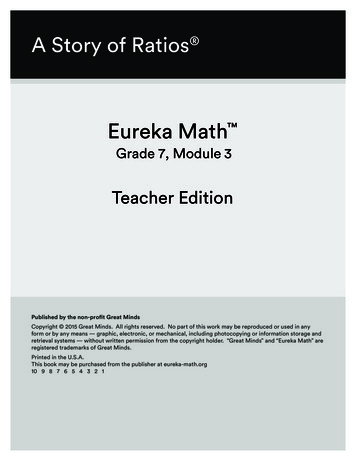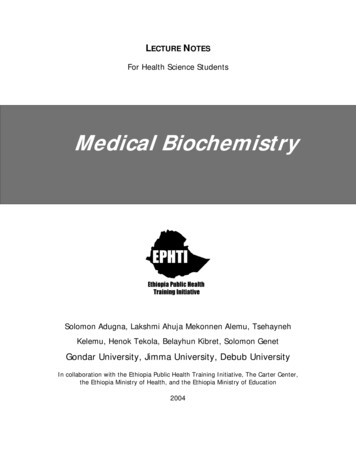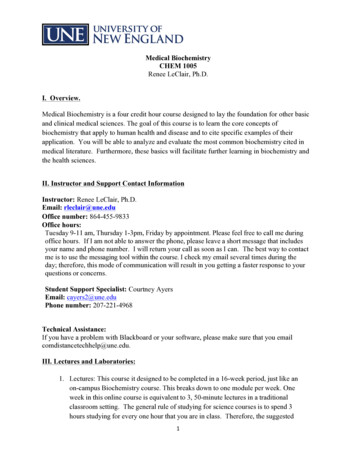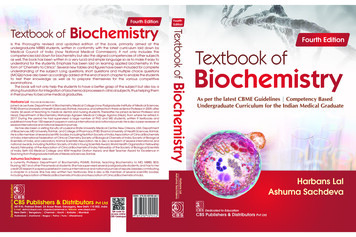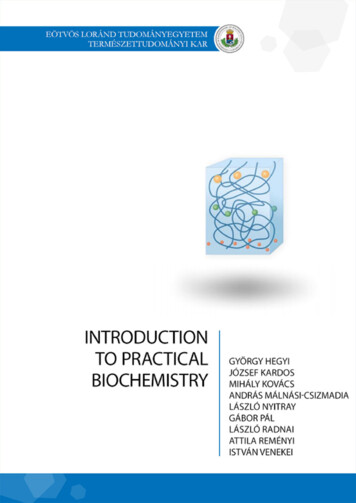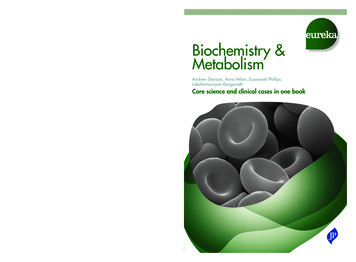
Transcription
eurekamedicine made cleareureka – an innovative series for students that fully integrates core science,clinical medicine and surgery. With its engaging and authoritative text, featuringinsightful clinical cases, graphic narratives, SBAs and a wealth of other learning tools,Eureka has everything students need to succeed in medicine and pass their exams. Systems-based chapters describe theprocesses that underpin normalfunction Clinical cases teach you to think likea doctor Graphic narratives bring cases to life Starter questions stimulate curiosityand learning Clinical SBAs chapter helps you reviseand pass your examsSeries Editors:Janine Henderson, David Oliveira, Stephen ParkerAndrew Davison, Anna Milan, Suzannah Phillips,Lakshminarayan RanganathCore science and clinical cases in one bookDavison, Milan, Phillips, Ranganath First principles chapter explains keyconcepts and mechanisms ofbiochemistryBiochemistry & MetabolismeurekaBiochemistry em COVER AW.indd 111/08/2015 13:42
eurekaBiochemistry & Metabolism
eurekaBiochemistry & MetabolismAndrew Davison BSc (Hons) MSc CSciEuSpLM FRCPathPrincipal Clinical Biochemist andHonorary Lecturer in ClinicalBiochemistryDepartment of Clinical BiochemistryLiverpool Clinical LaboratoriesRoyal Liverpool and BroadgreenUniversity Hospitals NHS TrustLiverpool, UKAnna Milan BSc (Hons) MSc PhDEuSpLM FRCPathPrincipal Clinical Biochemist andHonorary Lecturer in ClinicalBiochemistryDepartment of Clinical BiochemistryLiverpool Clinical LaboratoriesRoyal Liverpool and BroadgreenUniversity Hospitals NHS TrustLiverpool, UKSuzannah Phillips BSc (Hons) MSc PhDPrincipal Clinical Biochemist andHonorary Lecturer in ClinicalBiochemistryDepartment of Clinical BiochemistryLiverpool Clinical LaboratoriesRoyal Liverpool and BroadgreenUniversity Hospitals NHS TrustLiverpool, UKLakshminarayan Ranganath MDMBBS MSc PhD CSci FRCP FRCPathProfessor and Consultant in ChemicalPathologyDepartment of Clinical BiochemistryLiverpool Clinical LaboratoriesRoyal Liverpool and BroadgreenUniversity Hospitals NHS TrustLiverpool, UKSeries EditorsJanine Henderson MRCPsychMClinEdMB BS Programme DirectorHull York Medical SchoolYork, UKStephen Parker BSc MS DipMedEdFRCSConsultant Breast and GeneralPaediatric SurgeonSt Mary’s HospitalNewport, UKDavid Oliveira PhD FRCPProfessor of Renal MedicineSt George’s, University of LondonLondon, UKLondon Philadelphia New Delhi Panama City
2015 JP Medical Ltd.Published by JP Medical Ltd, 83 Victoria Street, London, SW1H 0HW, UKFirst reprint 2015Tel: 44 (0)20 3170 8910Fax: 44 (0)20 3008 6180Email: info@jpmedpub.comWeb: www.jpmedpub.comThe rights of Andrew Davison, Anna Milan, Suzannah Phillips and Lakshminarayan Ranganath to be identifiedas the authors of this work have been asserted by them in accordance with the Copyright, Designs andPatents Act 1988.All rights reserved. No part of this publication may be reproduced, stored or transmitted in any form orby any means, electronic, mechanical, photocopying, recording or otherwise, except as permitted by theUK Copyright, Designs and Patents Act 1988, without the prior permission in writing of the publishers.Permissions may be sought directly from JP Medical Ltd at the address printed above.All brand names and product names used in this book are trade names, service marks, trademarks orregistered trademarks of their respective owners. The publisher is not associated with any product or vendormentioned in this book.Medical knowledge and practice change constantly. This book is designed to provide accurate, authoritativeinformation about the subject matter in question. However readers are advised to check the most currentinformation available on procedures included and check information from the manufacturer of each productto be administered, to verify the recommended dose, formula, method and duration of administration,adverse effects and contraindications. It is the responsibility of the practitioner to take all appropriate safetyprecautions. Neither the publisher nor the authors assume any liability for any injury and/or damage topersons or property arising from or related to use of material in this book.This book is sold on the understanding that the publisher is not engaged in providing professional medicalservices. If such advice or services are required, the services of a competent medical professional should besought.Every effort has been made where necessary to contact holders of copyright to obtain permission toreproduce copyright material. If any have been inadvertently overlooked, the publisher will be pleased tomake the necessary arrangements at the first opportunity.ISBN: 978-1-907816-83-3British Library Cataloguing in Publication DataA catalogue record for this book is available from the British LibraryLibrary of Congress Cataloging in Publication DataA catalog record for this book is available from the Library of CongressPublisher:Richard FurnDevelopment Editors: Thomas Fletcher, Paul Mayhew, Alison WhitehouseEditorial Assistants:Sophie Woolven, Katie PattulloCopy Editor:Kim HowellGraphic narratives;James PollittCover design:Forbes DesignInterior design:Designers Collective Ltd
eurekaSeries Editors’ ForewordToday’s medical students need to know a great deal to be effective as tomorrow’s doctors.This knowledge includes core science and clinical skills, from understanding biochemicalpathways to communicating with patients. Modern medical school curricula integrate thisteaching, thereby emphasising how learning in one area can support and reinforce another.At the same time students must acquire sound clinical reasoning skills, working withcomplex information to understand each individual’s unique medical problems.The Eureka series is designed to cover all aspects of today’s medical curricula and reinforcethis integrated approach. Each book can be used from first year through to qualification.Core biomedical principles are introduced but given relevant clinical context: the authors havealways asked themselves, ‘why does the aspiring clinician need to know this’?Each clinical title in the series is grounded in the relevant core science, which is introducedat the start of each book. Each core science title integrates and emphasises clinical relevancethroughout. Medical and surgical approaches are included to provide a complete andintegrated view of the patient management options available to the clinician. Clinicalinsights highlight key facts and principles drawn from medical practice. Cases featuringunique graphic narratives are presented with clear explanations that show how experiencedclinicians think, enabling students to develop their own clinical reasoning and decisionmaking. Clinical SBAs help with exam revision while Starter questions are a unique learningtool designed to stimulate interest in the subject.Having biomedical principles and clinical applications together in one book will maketheir connections more explicit and easier to remember. Alongside repeated exposure topatients and practice of clinical and communication skills, we hope Eureka will equip medicalstudents for a lifetime of successful clinical practice.Janine Henderson, David Oliveira, Stephen Parker
viAbout the Series EditorsJanine Henderson is the MB BS undergraduate Programme Director at Hull York MedicalSchool (HYMS). After medical school at the University of Oxford and clinical training inpsychiatry, she combined her work as a consultant with postgraduate teaching roles,moving to the new Hull York Medical School in 2004. She has a particular interest in moderneducational methods, curriculum design and clinical reasoning.David Oliveira is Professor of Renal Medicine at St George’s, University of London (SGUL),where he served as the MBBS Course Director between 2007 and 2013. Having trainedat Cambridge University and the Westminster Hospital he obtained a PhD in cellularimmunology and worked as a renal physician before being appointed as Foundation Chair ofRenal Medicine at SGUL.Stephen Parker is a Consultant Breast and General Paediatric Surgeon at St Mary’sHospital, Isle of Wight. He trained at St George’s, University of London, and after servicein the Royal Navy was appointed as Consultant Surgeon at University Hospital Coventry.He has a particular interest in e-learning and the use of multimedia platforms in medicaleducation.About the AuthorsAndrew Davison is a Principal Clinical Biochemist with a special interest inphaeochromocytoma and one of the co-leads for the MSc course in Clinical Biochemistryat the University of Manchester. He has a keen interest in teaching undergraduate andpostgraduate students about the science behind clinical medicine.Anna Milan is a Principal Clinical Biochemist with a keen interest in bone markers,vitamins, mineralised tissue biochemistry and alkaptonuria. She is an Honorary Lecturer atthe University of Liverpool and also lectures on the MSc course in Clinical Biochemistry atthe University of Manchester. She has over 15 years’ experience in teaching at all levels, inclinical and non-clinical settings, through lectures and problem-based learning examples.Suzannah Phillips is a Principal Clinical Biochemist at the Royal Liverpool UniversityHospital. She has over 10 years’ experience in teaching both undergraduate andpostgraduate students and coordinates undergraduate medical teaching in clinicalbiochemistry. She also lectures on the MSc course in Clinical Biochemistry at the Universityof Manchester.Lakshminarayan Ranganath is a Consultant Chemical Pathologist at the Royal LiverpoolUniversity Hospital and Clinical Director of the National Alkaptonuria Centre. He hasextensive experience in teaching students, medical and non-medical trainees.
viiPrefaceKnowledge of biochemistry is vital to the practise of clinical medicine, providing anunderstanding of disease processes at the molecular level. It is essential that clinicians andscientists have a firm grasp of the science that underpins disease, in order to select theappropriate treatment and investigations for their patients.Eureka Biochemistry & Metabolism covers the fundamental building blocks of life, frombasic metabolism to the investigation of disease. Chapter 1 provides an introduction tocellular structure and function, biochemical reactions and body fuels. Chapters 2-6 buildon these themes and are enhanced by clinical cases; these highlight the importance ofthe core science and emphasise its relevance to real life and clinical medicine. Chapters 7and 8 describe fluid and electrolyte balance and nutrition; like all the other chapters theyinclude clinical insights to help clinicians make informed decisions around patient care.Lastly, chapter 9 provides an invaluable revision aid for undergraduate students in theform of clinical SBAs.Throughout Eureka Biochemistry & Metabolism, we include diagrams and uniquegraphic narratives to help students understand key concepts. We have made every effortto carefully explain the knowledge you will need to succeed in your exams and become asuccessful doctor. We hope you enjoy the book and find it useful.Andrew Davison, Anna Milan, Suzannah Phillips, Lakshminarayan RanganathApril 2015
viiiContentsSeries Editors’ ForewordvProtein structure and function83About the Series EditorsviProtein turnover87About the pter 1 First principlesChapter 4 CarbohydratesIntroduction93Case 3 Collapsed and unresponsive94Chemical energy96Glucose breakdown102Introduction1The pentose phosphate pathway107Overview1The citric acid cycle110Cell structure3Oxidative phosphorylation112Cell membranes and the transportof molecules and ions8Glycogen116Signalling pathways14Enzymes and cofactors20Biochemical bonds and reactions26Body fuels32Chapter 2 Nucleic acidsIntroduction43Case 1 Pain and swelling in a big toe44Nucleotides46Nucleotide synthesis49Nucleotide degradation54Drugs targeting nucleotide metabolism56Nucleic acid structure57Nucleic acid synthesis60Mutations65Chapter 3 ProteinsIntroduction69Case 2 Seizure and lethargy in a baby70Amino acids72Protein synthesis79Gluconeogenesis119Other fuels: fructose and galactose121Chapter 5 LipidsIntroduction125Case 4 Tiredness and tingling fingers126Lipid structures128Lipolysis129Lipogenesis135Ketone body metabolism140Cholesterol metabolism141Chapter 6 HaemoglobinmetabolismIntroduction153Case 5 Chest pain154Blood cells156Haemoglobin structure159Haemoglobin synthesis160Haemoglobin breakdown163Iron homeostasis165
ContentsHaemoglobin function170Disorders of haemoglobin174Chapter 7 Body fluidhomeostasisIntroductionCase 6 Injuries sustained in a trafficcollision179180Chapter 8 NutritionIntroduction203Case 7 Yellow skin and diarrhoea205Energy balance207Vitamins209Minerals and trace elements223Nutrition and disease227pH181Systems that maintain acid–basehomeostasis182SBA questions237Acid–base balance187SBA answers245Maintenance of fluid balance191Maintenance of electrolyte balance194Index253Chapter 9 Self-assessmentix
xGlossaryDNAdeoxyribonucleic acidABCA1 ATP-binding cassette transporter A1dNTPdeoxyribonucleoside triphosphateABCG1 ATP-binding cassette transporter G1A siteaminoacyl sitedTMPdeoxythymidine monophosphateACEangiotensin-converting enzymedTTPdeoxythymidine triphosphateADPadenosine diphosphatedUDPdeoxyuridine diphosphateADHantidiuretic hormonedUMPdeoxyuridine monophosphateAMPadenine monophosphatedUTPdeoxyuridine triphosphateANPatrial natriuretic peptideAPRTadenine phosphoribosyltransferaseEenzymeATPadenosine triphosphateEDTAethylenediaminetetra-acetic acidAVParginine vasopressinFferroportin 1BMDbone mineral densityFAD BNPbrain natriuretic peptideflavin adenine dinucleotide (oxidisedform)FADH2ratio of number of carbonatoms:double bondsflavin adenine dinucleotide (reducedform)Fe2 oxidising ironcAMPcyclic adenosine monophosphateFe3 ferric ironCDPcytidine diphosphateFMNflavin mononucleotide (reduced form)CEcholesterol esterCHOLcholesterolGGibbs free energycytidine monophosphateGDPguanosine diphosphatecoenzyme AGLUTglucose transporterGMPguanine monophosphatecytidine triphosphateGPgeneral practitionercytochromeG-protein guanine nucleotide–binding proteinC:DCMPCoACoASH coenzyme A (reduced form)CTPcytGTPguanosine triphosphatedADPdeoxyadenosine e triphosphateHhephaestindeoxycytidine diphosphateHbhaemoglobindCTPdeoxycytidine triphosphateHbAadult haemoglobinDEXAdual-energy X-ray absorptiometryHbA 2haemoglobin A2dGDPdeoxyguanosine diphosphateHbChaemoglobin Cdeoxyguanosine triphosphateHbDhaemoglobin DDHFdihydrofolateHbDpunjab haemoglobin PunjabDHFRdihydrofolate reductaseHbFfetal haemoglobinDMT-1divalent metal iron transporter-1Hbleporehaemoglobin LeporedATPdCDPdGTP
Glossaryphospholipidhaemoglobin MPLHbSsickle haemoglobinpre-mRNA precursor messenger ribonucleic acidHbSSsickle cell anaemiapre-RNA precursor ribonucleic acidHDLhigh-density lipoproteinpre-rRNA precursor ribosomal ribonucleic ferasepre-tRNA precursor transfer ribonucleic acidHHhereditary haemochromatosisHbMHMG CoA 3-hydroxy-3-methylglutaryl CoAPRPP5-phosphoribosyl 1-pyrophosphateRANKreceptor-activated nuclear kappaRANKLreceptor-activated nuclear kappa-BligandIDLintermediate-density lipoproteinIMPinosine monophosphateRNAribonucleic acidIP3inositol 1,4,5-triphosphaterRNAribosomal ribonucleic acidKmMichaelis desLDLlow-density lipoproteinLp(a)lipoprotein(a);mRNAmessenger ribonucleic acidTHFtetrahydrofolateMTHFmethylene tetrahydrofolateTMPthymidine monophosphateTMPTthiopurine methyltransferaseTPNtotal parenteral nutritionnicotinamide adenine dinucleotide(oxidised form)TPPthiamine pyrophosphateTRHthyrotrophin-releasing hormoneNADHnicotinamide adenine dinucleotide(reduced form)tRNAtransfer ribonucleic acidNADP nicotinamide adenine dinucleotidephosphate (oxidised form)TSHthyroid-stimulating hormoneUDPuridine diphosphateUMPuridine monophosphateUTPuridine triphosphateMTHFR methylenetetrahydrofolate reductaseNAD NADPH nicotinamide adenine dinucleotidephosphate (reduced form)P sitepeptidyl sitePproductVLDLvery-low-density lipoproteinPiinorganic phosphateVmaxmaximum rate (velocity) of reactionPIP2phosphatidylinositol 4,5-bisphosphatexi
xiiAcknowledgementsThanks to the following medical students for their help reviewing chapters: Jessica Dunlop,Aliza Imam, Roxanne McVittie, Daniel Roberts and Joseph Suich.
93Chapter 4CarbohydratesIntroduction. . . . . . . . . . . . . . . . . . . . 93Case 3 C ollapsed andunresponsive. . . . . . . . . . . . . 94Chemical energy . . . . . . . . . . . . . . . . 96Glucose breakdown. . . . . . . . . . . . . 102The pentose phosphatepathway. . . . . . . . . . . . . . . . . . . . . . 107The citric acid cycle . . . . . . . . . . . . . 110Oxidative phosphorylation. . . . . . . 112Glycogen. . . . . . . . . . . . . . . . . . . . . . 116Gluconeogenesis. . . . . . . . . . . . . . . 119Other fuels: fructose and galactose. 121Starter questionsAnswers to the following questions are on page 122.1. Why is fructose a ‘quicker’ source of energy than glucose?2. What is the difference between the d- and l-forms of glucose?3. Why is the brain solely dependent on glucose for energy?4. Is muscle burn caused by a build-up of lactic acid?5. Why are mitochondria considered the powerhouses of cells?6. Why does cyanide poisoning work so quickly?IntroductionCarbohydrates are molecules containingcarbon, hydrogen and oxygen. As the nameimplies, they are generally hydrates of carbon, and as in water, they contain hydrogenand oxygen in a ratio of 2:1. They are structurally termed saccharides (Latin: saccharum,‘sugar’) and are divided into four chemicalgroups: mono-, di-, oligo- and polysaccharides.Although a common source of energy,carbohydrates are not an essential nutrient,because humans are able to obtain 100% oftheir daily energy requirement from proteinand fat. Neither are carbohydrates essentialfor the synthesis of other molecules. However, they are more readily converted thanprotein or fat into the key energy monosaccharide: glucose.When digested, all carbohydrates are broken down to glucose, which is then transported in the blood to cells for energy production.Carbohydrate is one of the main productsof photosynthesis in plants, predominantlyglucose and is the main fuel for cellular respiration to produce energy, carbon dioxideand water.
94Chapter 4 CarbohydratesCase 3 Collapsed and unresponsivePresentationAnalysisThe blood test results (Table 4.1) show:Charles Lee, aged 32 years, presents to DrSloane in the emergency department. MrLee has collapsed and is unresponsive.He has a long history of self-neglect andalcohol misuse.Clinical examination identified apale, underweight man who felt clammyto the touch. Dr Sloane smelt alcohol.As Mr Lee was unresponsive he was unable to question him to his lifestyle andany current medications. There was nosign of trauma and blood pressure andheart rate were stable (110/70 mmHg and65 bpm respectively).Dr Sloane orders blood tests to assessMr Lee’s nutritional status and liver function. Based upon his history the collapseis most likely to be the result of alcoholdependent nutritional deficiencies andliver dysfunction. low serum glucose (hypoglycaemia)markedly increased g-glutamyltransferaseBlood test resultsTestResultReferencerangeGlucose (mmol/L)1.93.5–5.0g-Glutamyl transferase (U/L)352 35Potassium (mmol/L)2.63.5–5.3Magnesium (mmol/L)0.400.70–1.0Phosphate (mmol/L)0.340.7–1.40Table 4.1 Blood test results for a man who hascollapsed and is unresponsiveHypoglycaemia: causes, investigation and treatmentThe emergency department is contacted by thelaboratory with severely abnormal biochemistryresults on one of their patientsCharles Lee has a verylow glucose of 1.9mmol/LHypoglycaemia is a lifethreatening conditionwith five main causesI’ll get bloods for insulin andC-peptide, to rule out exogenousinsulin overdose or insulinoma Insulin GlucagonCharles is treated immediately withIV dextrose. Blood samples are alsotaken whilst he is hypoglycaemic, toinvestigate the causeHe’s also unresponsive,we’ll review himimmediatelyHis blood ethanolis high tooHypoglycaemiaAlcohol CortisolThe insulin andC-peptide areappropriatelylow. His alcoholabuse is themost likelycause GlycogenMedicationsHow does that causehypoglycaemia?Alcoholics are often malnourishedand have low glycogen storesAlso, ethanol metabolism increasesthe NADH/NAD ratio in the cell,which impairs gluconeogenesisThe cause of his hypoglycaemia isdiscussed at ward round
Case 3 Collapsed and unresponsiveCase 3 continued decreased potassium (hypokalaemia),magnesium (hypomagnesaemia) andphosphate (hypophosphataemia)In this clinical context, the probable explanations are hypoglycaemia reflectingthe inability to mount a glyconeogeneticresponse due to a malnourished state, highg-glutamyl transferase as a result of alcoholic liver damage, and lowered electrolytes secondary to nutritional deficiencies.Further caseTo aid Dr Sloane’s differential diagnosisfurther laboratory tests were requested onMr Lee to measure insulin and C-peptide.Both were undetectable indicating a noninsulin mediated hypoglycaemia.Mr Lee is admitted to hospital for intravenous replacement of potassium, magnesium and phosphate. Glucose is alsogiven intravenously. After several hourshe is sitting up in bed, alert and chattingto the doctor.Further analysisThe insulin and C-peptide measurementswere indicated by Mr Lee’s hypoglycaemia to confirm that excess insulin is notresponsible for his condition. C- (connecting-) peptide is a by-product of thebreakdown of proinsulin to active insulin, therefore its concentration is used toassess insulin production.Hypoglycaemia is common in patientswho consume excessive amounts of alcohol without adequate nutrition. In thisgroup of patients, the condition is a consequence of: low glycogen storesimpaired citric acid cycle andgluconeogenesis; ethanol metabolismby alcohol dehydrogenase reducesNAD to NADH; the next step in themetabolism of alcohol by aldehydedehydrogenase also reduces NAD toNADH thereby increasing the NADH/NAD ratio. This change affectsgluconeogenesisThis change in NADH negatively affectsenzymes in the gluconeogenesis pathway.Conversion of lactate to pyruvate is inhibited and lactate production is favoured;production of oxaloacetate from malateis inhibited. However other mechanismsfor glucose production such as glycogenolysis can still occur. Mr Lee has a poornutritional intake so glycogen stores areminimal. Alcohol misuse is associatedwith nutritional deficiencies resultingfrom a poor diet and inhibition of digestive enzymes by alcohol will impair nutrient absoprtion. These lead to electrolytedeficiencies requiring oral or intravenoussupplementation.Mr Lee’s collapse was caused by hypoglycaemia secondary to alcohol inhibiting gluconeogenesis. He is referred to analcohol withdrawal programme, advisedon eating and lifestyle changes and prescribed multi-vitamins to help correctnutritional deficiencies.g-Glutamyl transferase concentrationis increased in 75% of patients withlong-term alcohol misuse. This resultindicates oxidative damage to theliver.95
Chapter 4 CarbohydratesChemical energyChemical energy is energy stored in thebonds of chemical compounds. This energyis released in chemical reactions.Food is an example of stored chemical energy. Digestion breaks down the moleculesin food into smaller components. Energy isreleased by the breaking of bonds during thechemical reactions in this process.Carbohydrates are the central moleculesof metabolic energy in all forms of organism; they are used to both store and generateenergy. Their widespread use is probablypartly the consequence of the developmentof photosynthesis by cyanobacteria about3.6 billion years ago. Photosynthesis harnesses the energy of sunlight to form chemical bonds, and glucose is one of its products.Food energyMonosaccharidesMonosaccharides are the simplest carbohydrates, because they cannot be hydrolysed tosmaller carbohydrates. They all have the general formula (C.H2O)n and include glucose,fructose and galactose.The following characteristics are used toclassify monosaccharides (Figure 4.1). Carbonyl group: if this is an aldehyde, themonosaccharide is an aldoseNumber of carbon atoms: three fortrioses, four for tetroses, five for pentosesand six for hexosesChiral nature: the classification of dor l is based on the orientation of theasymmetrical carbon furthest from thecarbonyl groupd-sugars have a hydroxyl group on theright l-sugars have a hydroxyl group on theleft (easily remembered as ‘l’ for left)As an example, under this classificationd-glucose is an aldohexose.Monosaccharides, predominately glucose, are the major source of fuel for metabolism. They are broken down in the cytoplasm by the citric acid cycle, then furtherutilised by mitochondria to produce adenosine triphosphate (ATP). When not required, Energy in food is released by the metabolicpathways described in this chapter, andis measured in kilocalories or kilojoules(Table 4.2). Carbohydrate, protein and fatdiffer in structure, so they are broken downin different pathways. However, their metabolites enter shared pathways, the final common pathways that release energy.The production, storage and use of energyare fundamental to cells; they also requireenergy to do all their work. Therefore an understanding of biochemical energetics provides the basis for an understanding of metabolism (see page 31).Structure of d-glucoseHOEnergy content of foodsC 96HCOHHOCHComponentEnergy (kcal/g)Energy 28Alcohol729The joule is the most widely SI unit used to measureenergyTable 4.2 Energy content of major food groupsCH2OHFigure 4.1 Structure of d-glucose.Monosaccharides are classified by carbonyl group(orange), number of carbon atoms and chiralnature. The classification of d or l is based on theorientation of the asymmetrical carbon furthestfrom the carbonyl group (blue).
Chemical energymonosaccharides are converted to spaceefficient, insoluble storage polysaccharidessuch as glycogen.A kilocalorie is commonly referred toas a calorie, and is the energy requiredto increase the temperature of 1 g ofwater by 1 C. A kilojoule is equivalentto 4.2 kilocalories.DisaccharidesDisaccharides are two monosaccharaidesjoined by a covalent bond formed by a dehydration reaction. The reaction results in theloss of hydrogen from one monosaccharideand a hydroxyl group from the other. Energy transferThe body transfers energy by breaking andmaking bonds. Glucose is the main moleculeof energy exchange. However, it is ATP, andthe phosphate phosphate bonds it contains,that directly supplies chemical reactionswith the energy they need.Sucrose (table sugar) is a disaccharideformed from d-glucose and d-fructoseLactose is formed from d-galactose andd-glucoseOligosaccharidesAdenosine triphosphateOligosaccharides are polymers of monosaccharides. They are generally O-linked toamino acid side chains in proteins or lipids.O-linked glycosylation is when glycans (sugars) are attached to the hydroxyl oxygen of theamino acids serine, threonine, tyrosine orhydroxylysine and hydroxyproline. The glycans can also be O-linked to oxygens on lipids.Oligosaccharides differ from polysaccharides in the number of linked monosaccharideunits. Oligosaccharides contain two to ten,whereas polysaccharides contain hundreds.Adenosine triphosphate (ATP) is the body’smain currency of energy; it is an adenosinemolecule (adenine ring and a ribose sugar)attached to three phosphate groups (Figure 4.2). Energy is released by hydrolysis of the3rd phosphate group, whose removal producesadenosine diphosphate (ADP). ADP absorbsenergy during cellular processes and thusregains a phosphate group, regenerating ATP.The total amount of ATP in the humanbody is about 0.1 mol. The energy useddaily by an average-sized adult requireshydrolysis of 200–300 mol of ATP. Toachieve this, each molecule of ATP isrecycled 2000–3000 times during the day.Sweetness is caused by the activationof taste receptors on the tongueby hydroxyl groups with certainorientations. Through evolution,humans developed their sensitivity andattraction to sweetness because of itsvalue as a readily metabolised source ofabundant energy.Phosphates are high-energy molecules. Theyrelease high levels of energy when individualphosphate groups are removed.Figure 4.2 Structure of adenosinetriphosphate.ATP structureNH2High-energyanhydride linkagesO O NO O — P — O — P — O — P — O — CH2 –––OOOγβαHThree phosphategroupsNEster linkageOHNHOHOHRiboseNAdenineH97
98Chapter 4 CarbohydratesEnergy for reactionsRedox coenzymesThe dephosphorylation reaction of ATP toADP is frequently coupled to another reaction to exploit the release of energy. Releaseof phosphate is exothermic (gives off heat)and can be joined to an endothermic reaction (one that requires energy or heat). Thephosphate group is transferred to anothercompound (phosphorylation) to produceADP, phosphate and energy.The phosphate bond in ATP containssufficient energy to supply most reactions.When more energy is needed, ATP is able torelease two phosphate groups. This producesadenosine monophosphate (AMP) and pyrophosphate, which has two phosphate groups.In metabolism, specific enzymes catalyseoxidation. Cofactors of these enzymes,(coenzymes), usually act as carriers for theproducts of reactions.In metabolism, three key coenzymes areresponsible for the transduction of energy:Other energy currenciesAlthough ATP is the main energy carrier,other nucleotide phosphates are also usedas energy currencies. The citric acid cy
medicine made clear Biochemistry & Metabolism Davison, Milan, Phillips, Ranganath eureka Series Editors: Janine Henderson, David Oliveira, Stephen Parker www.eurekamedicine.com Biochemistry & Metabolism Andrew Davison, Anna Milan, Suzannah Phillips, Lakshminarayan Ranganath Core scien
